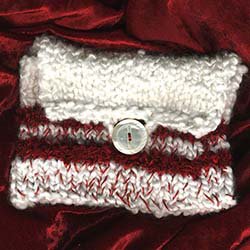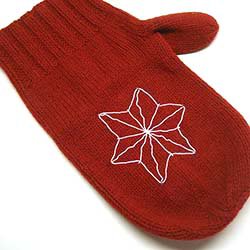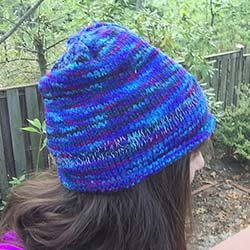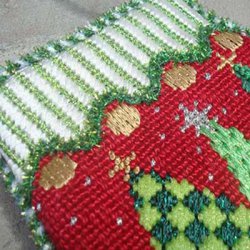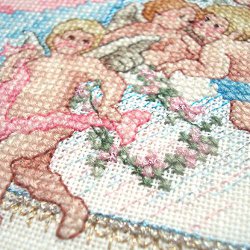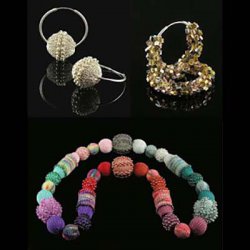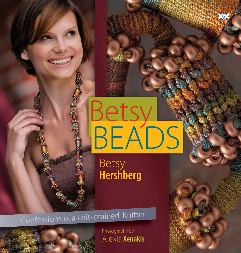-
Peppermint Pocket
Note: this item is not shipped
Designed by Amy Law
Here's a fun pocket-sized project to knit as a gift bag, money holder, or gift card holder this season. The metallic thread adds that touch of holiday magic.
Materials:
- 1 skein Lion Brand Homespun, 300 Hepplewhite (white)
- 1 skein Cotton Flamme, Crystal Palace Yarns, 0032 (deep red)
- 1 skein Berroco Chinchilla Bulky, Cabernet 7567 (deep red)
- 1 10m spool Kreinik Metallic Thread, #16 Braid 003 Red
- 1 button
- Tools: scissors, sewing needle, #5 12 inch circular needles, #5 Straight needles
Instructions:
- Cast on 40 stitches, leaving 15" tail (you will use this to sew your bottom closed)
- Knit 7 rows of White Homespun & Metallic
- Knit 3 rows of Red Cotton & Chinchilla
- Knit 5 rows of White Homespun & Metallic
- Knit 3 rows of Red Cotton & Chinchilla
- Knit 7 rows of White Homespun Bind off 20 stitches (move to straight needles if preferred)
- Knit 15 rows of White Homespun Bind off edge Sew back to middle of edge, create button loop
- Weave in end Stitch bottom of pocket shut and weave in end Attach button
Notes: - You will not use a full skein of any of the yarns - You will use a full spool of Kreinik
-
Christmas Mitt
Note: this item is not shipped. Download the PDF project instructions below.
Designed by Diane Zangl
Stockings aren’t the only thing that can be hung by the chimney with care. Why not start a new tradition and hang mittens instead? This oversize mitten is knit in the same manner as a hand-sized one using a double strand of yarn. It’s felted, then a poinsettia is added for a touch of whimsey. Santa would be pleased.
SKILL LEVEL: Intermediate
SIZE: Approximately 18” long after felting
MATERIALS:
- 10 yds Kreinik Pearl Facets #032 white
- 3 (100g/210 yd) skeins Plymouth Galway, 100% wool, #102 Red (MC)
- 12” scrap yarn in any contrasting color
- Size 10 1/2 (6.5mm) 16” circular and double pointed needles (dpn)
- Stitch markers
- Matching sewing thread
Instructions:
To download the instructions for this project, click here. -
Reflective Hat and Wristers Pattern
Note: this item is not shipped
Designed exclusively for Kreinik by Diane Zangl using Kreinik Reflective Yarn
Wristers and a classic watch style hat make up this set that makes a wonderful gift. Worked circular, the hat uses Stockinette stitch throughout, which causes the lower edge to roll organically. The fingerless mitts are worked as flat pieces from side to side. An opening is left for the thumb when the seam is sewn. Garter stitch along both edges forms the cuff ribbing. Reflective yarn is held together with the main yarn for the hat brim area, and as vertical stripes in the mitts.
SKILL LEVEL: Intermediate
Size: Adult S/M (M/L) Instructions are given for smallest size, with larger sizes in parentheses. When only 1 number is given, it applies to both sizes.
FINISHED MEASUREMENTS
HAT:
Circumference: 19 (20¾)”
Height: 9 (9½)”
MITTS:
Around Hand: 7½ (8½)”
Length: 7½ (8½)”
Materials needed:
- Kreinik Reflective Yarn, 53% glass beads/22% polyester/12% phenolic resin/13% adhesive: (1) 25-yd spool
- Brown Sheep Lana Bouclé, 97% wool/3% nylon (50g/180 yds per ball): 2 balls #202 Restless Sea (MC)
- Size 6 (4mm) double-pointed (dpn), 16” and 24” circular needles or size needed to obtain gauge
- Stitch markers
GAUGE
17 sts x 23 rnds = 4” in St st
To save time, take time to check gauge.
DESIGNER NOTES
• Two strands of Reflective yarn are held together with MC in areas indicated.
• Reflective yarn is most effective when it is toward the outside of stitch.
• Slip first st of mitts purlwise.
HAT
With MC and shorter circular needles, cast on 80 (88) sts. Join without twisting, placing marker between first and last st.
Work even in St st until hat measures 1½” without unrolling lower brim.
Join 2 strands of Reflective yarn and knit 4 rnds.
Cut Reflective and work in St st until hat meas-ures 8 (8½)” without unrolling brim.
Join 2 strands of Reflective yarn and change to dpn.
Shape top
Dec rnd: K2 tog around – 40 (44) sts.
Knit 2 rnds. Rep Dec rnd – 20 (22) sts.
Knit 1 rnd. Rep Dec rnd – 10 (11) rnds.
Size S/M only: K2tog around – 5 sts.
Size M/L only: [K2tog] 5 times, k1 – 6 sts.
Cut yarn and draw through remaining sts twice.
Pull yarn through to inside and weave in end.
MITTS
Left Mitt
With longer circular needle and MC, cast on 30 (34) sts, leaving a 12” ‘tail’ for sewing.
Row 1 (WS): Sl 1, k10 (cuff), place marker, p14 (18), place marker, k5 (top).
Row 2: Sl 1, knit to end of row.
Rep Rows 1-2 for a total of 7 (9) rows.
Next row (RS): Sl 1, k4, join 2 strands of Reflective and knit 14 (18) sts, drop Reflective and knit to end of row.
Work 4 more rows in established pat, carrying Reflective along with MC in St st area between markers only.
Cut Reflective, and work even in established pat until mitt measures 7½ (8½)” from beg, ending with a RS row.
Cut yarn, leaving a 12” end for sewing.
Right Mitt
With longer circular needle and MC, cast on 30 (34) sts, leaving a 12” ‘tail’ for sewing.
Row 2 (WS): Sl 1, k4, (top) place marker, p14 (18), place marker, k11 (cuff).
Row 2: Sl 1, knit to end of row.
Work as for Left Mitt, joining 2 strands of Reflective after 7 (9) rows have been completed, and working 5 rows in center area between markers. Complete as for Left Mitt.
Finishing
Place marker in top st of cuff, skip 8 sts, place second marker in next st. Sew cuff from lower edge to first marker.
Leaving marked area unsewn for thumb, sew remainder of seam from top edge to second marker.
-
How To Use Kreinik Micro Ice Chenille
Quick! Name five things that are fuzzy (bonus points for fuzzy metallic things). How about: garland on Christmas trees, legs on spiders, flower centers, bushy eyebrows, other, ahem, hairy things, peaches, caterpillars, lots of bugs actually, baby chicks, moldy cheese, your brain after a long weekend. How many could you list? Nature and life itself are full of texture. It makes things visually interesting and tactile.
You can recreate the fuzzy factor of true life objects with Kreinik's Micro Ice Chenille in your favorite hobby: needlepoint, cross stitch, embroidery, fly fishing, crochet, knitting, weaving. It adds whimsy, dimension, texture, and just plain visual interest to a design.What is Micro Ice Chenille and where can you use it?
- it's a fuzzy metallic
- couch in needlepoint, cross stitch, quilting, crazy quilting for surface embroidery (couch it with a Kreinik Cord or Very Fine #4 Braid, rather than stitch in and out)
- can also use it in long stitches in needlepoint if the canvas is not densely stitched (Micro Ice Chenille just doesn't like going in and out of fabric very much)
- combine it with any other fiber for cording and trims on stockings, ornaments, etc
- crochet little accessories and appliques (wreaths, flowers)
- use it in duplicate stitch in knitting (like a spider!)
To use in weaving:
- Can be used in weft, not for warp (too much stress)
- Weight/Yardage: Kreinik metallic yarns are not measured in terms of weight like wool or cotton yarns are, so measure by yard or meter. Purchase 50-meter cones; or cones of any amount by special order.
- Sett = 5 epi
- Care: Kreinik metallics don't felt, and are inelastic compared to some other types of yarns, so for best results, we recommend testing the threads with the weaving yarns you plan to use before beginning your project.
- Tips from weaver Deb Essen of DJE Handwovens: 1. Pull the thread off the cone horizontally, not from the top, to avoid adding twist to the fiber. 2. Combine with other yarns (rather than use a metallic exclusively) as an accent yarn for best results ("It makes a great, fun fabric"). 3. Test how the textures work together before making your main project: make test swatches if using stretchy yarns with the inelastic metallics, for instance, then use a warm-water wash for the wet-finishing. 4. You may want to experiment with looser sett to vary drapability. 5. Play! Have fun! "I love how the colors pop in sunlight or lamplight and shimmer as the piece is moved."
Content:
Cotton core, polyester metallic
-
How to use Blending Filament
Applications:
Blackwork, crewel, crochet, cross stitch/counted thread, doll making (by hand and machine), fly fishing, hardanger, knitting (by hand), lace making, machine embroidery/bobbin work, machine embroidery/in the needle, miniatures, needlepoint/canvas work, punch embroidery, silk gauze/Polysil embroidery, smocking, stumpwork, weaving, and many more.
Hand Embroidery:
The thin quality of Blending Filament allows you to create elements of subtle light reflection. It is often combined with cotton, wool or another thread type, in the same needle, to create a random metallic sparkle. The addition of one or two strands does not add weight to your thread, so you can use the needle size that accommodates the stranded cotton. Vary the amount of highlight or shimmer you want to add to a design by using one or more strands; use a single strand for the most subtlety or two strands for added effect.
Overstitching & Texture:There's more to Blending Filament than just 'blending,' however. You can also use Blending Filament by itself to overstitch, bringing a reflective highlight or glow to a particular spot. Also, use a single strand of Blending Filament by itself in half-cross stitches for backgrounds on fabric; it creates a slight texture and subtle shimmer.
Tips on using Kreinik Blending Filament in hand work:
- Use short lengths of thread — about 45cm (18 inches) or less — to avoid excessive abrasion when pulling the thread through the ground fabric or canvas. The more a strand is pulled through fabric or canvas, the more 'wear' it causes on the thread. Using shorter lengths will maintain the quality of the thread, plus reduce tangling as shorter lengths are easier to control (less knotting!). If you are stitching on fabric, use a needle large enough to 'open' the hole in the fabric sufficiently and allow the thread(s) to go through more easily; this reduces friction and fraying.
- If combining Blending Filament with another thread type in a needle, you may wish to moisten the filament together with the other thread with a slightly damp, soft cosmetic sponge. This can help to control both thread types as they work together in your needle.
- Stitch slowly with Blending Filament to achieve more control and uniformity in stitching.
- Let your needle hang frequently to let the thread untwist and thus reduce knotting.
- If using Hi Lustre Blending Filament, lay the filament flat and smooth as you stitch to allow maximum light reflection. Think of it as a tiny ribbon; using a laying tool can help prevent twisting, or simply use your finger to lay the thread.
Machine Embroidery:
Blending Filament creates three-dimensional effects whether used in the needle or the bobbin of a sewing machine with specific embroidery patterns or free-motion techniques. It is ideal for art quilts and wearable art. Blending Filament also creates delicate reflective highlights in programmed patterns on embroidery machines. Kreinik offers an extensive color range to match fabric or mood.
Tips on using Kreinik Blending Filament with a sewing machine or serger:- When using Blending Filament in the needle, try a Metalfil or Metallica needle. You will need to loosen the top tension and adjust the bottom tension; practice until you get a combination that works with your machine, stitches, and fabric choice.
- When using Blending Filament in the bobbin for needle lace or other effects, experiment with different tension settings until you find a combination that achieves the look you want on your fabric. A 50m reel of Blending Filament fills a bobbin nicely.
- You can also combine Blending Filament with other threads or use it alone in a serger. Estimate 10 times the length to be sewn for thread yardage when using without mixing with other threads.
Care:
Kreinik Blending Filament is hand or machine washable and dry cleanable. Cool water is recommended. Do not use bleach. It can also be tumble-dried on low setting. When ironing a finished piece containing Blending Filament, do not iron directly on the thread; use a cloth, and do not use steam.
-
How to use silk & metallics in bead knitting & bead crochet
You may not think that the thread shows much in beading, or matters much, but it does. We asked designers what they thought of Kreinik threads, and they offered helpful tips to share with you. Whether you're getting into bead crochet, bead knitting, surface embroidery, or other types of beadwork, Kreinik metallic and silk threads offer some benefits that you just can't get with other threads, such as:
1. 200+ colors from which to pick — "For beaded embroidery, the thread color should match the fabric or the beads," notes designer Kim Kotary. With the large range of Kreinik shades, you can find a color to match any bead.
2. Did we mention 200+ colors: With such a wide range, you have more complementary color choices when working a design where the thread shows around the beads. "Kreinik threads are SO PRETTY," says designer Vashti Braha.
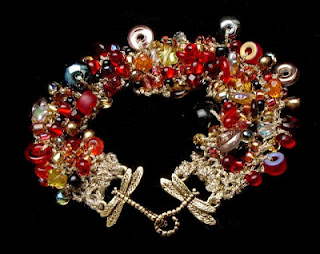
Bead Stew "Fire Walk with Me" by Earth Faire 3. Metallics add elements of light to designs — "it catches the light" says designer Maria del Pinto, and it complements the color depth of dichroic and Venetian glass beads, for instance. "Metallic threads add a wonderful shimmer to the beaded knit," notes designer Brenda Franklin. She adds that a transparent bead on a metallic thread will have the shimmer and glow you look for in a silver-lined beads (lined beads often have smaller holes and lose their glow). Designer Betsy Hershberg says Kreinik Cable in particular "is a great choice for a true metallic jewelry look."
4. Kreinik metallic braids, cables, and ribbons are strong: Brenda Franklin notes in her book Beaded Knits Vol. 1 that "glass beads add weight, so the thread that is used for beaded knits must be able to support this extra weight." Brenda often uses Kreinik #8, 12 and 16 Braids for her projects. Vashti Braha uses the metallics "when I need just the right way to feature a dichroic glass pendant. Kreinik stands up to the kind of metallic color depth, and the sheer weight of the glass pieces."
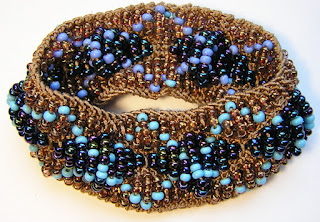
Reversible Bracelet by Brenda Franklin 5. Kreinik silk threads are strong. Silk is natural and one of the strongest fibers you can find. Betsy Hershberg had this to report after trying Kreinik Silk Serica for projects in her book, Betsy Beads: "The silk is a joy to knit/bead with. I'm not sure if I can accurately describe one of its favorite qualities for me as a knitter, but it has to do with a certain amount of "stickiness" it has that allows it to hold for a very even tension i.e., the stitches stay the same size rather than slipping as a rayon thread might. And don't even get me started on the color range..... I am thrilled to have discovered it." About Silk Serica, she adds, "I just love the sheen and the hand of the silk and it stands up really well to the friction of being strung with quite small beads. The stitch definition is beautiful. And it is SO strong!"
6. Kreinik threads are flexible, won't kink: From Earth Faire, a bead and jewelry kit company, "These are very easy threads to use -- unlike most metallics, I haven't found in these a tendency to kink -- they lie smoothly and work well with just about all of the size beads that we use."
7. Kreinik metallics are hand and machine washable: Cotton threads tend to stretch, but with the Kreinik metallics, "stretching when wet is not an issue," notes Earth Faire.
8. They come in a variety of weights/sizes: About Kreinik Tapestry #12 Braid, for example, Vashti notes, "This thread seems to bridge sizes #10 and #20 cotton threads." Kreinik has six sizes of metallic braid, two sizes of metallic ribbon, and three sizes of silk thread, which means you can pick from several options to either match bead sizes or to create your own yarn/thread by combining with other thread types. Some of the thinner threads, like Kreinik Blending Filament and Very Fine #4 Braid work well as carry-along fibers.
9. You can get thread in a variety of spool sizes: Since Kreinik makes their own threads, we can spool or cone any amount. Working on a large project, for instance? Choose a 50m cone, or special-order a custom size. The standard Kreinik spool sizes - from 10m to 20m on a spool — are ideal amounts for most jewelry projects.
Examples of what you can make
- Beaded earrings
- Beaded brooches
- Beaded necklaces
- Beaded ornaments
- Beaded pendants
- Beaded purses
- Beaded socks
- Beaded embroidery
- Beaded trim for garments, home decor, fashion accessories
Which threads to use
METAL/STEEL HOOKS AND NEEDLES:
Consensus among bead knitters/crocheters is that metal hooks and needles work better than plastic or wooden ones. From designer Maria del Pinto: "You need a metal crochet hook because the plastic ones have surfaces that catch the threads which can ruin the finished look of a piece." Gwen Blakley Kinsler, founder of the Crochet Guild of America, adds, "Depending on the thread, I use a steel hook, sizes 6, 7 or 8."
KREINIK METALLIC THREADS:
- Fine #8 Braid is great for crochet and fine needle lace work, and works well with size 11 seed beads.
- Fine #8 Braid is frequently used by Earth Faire for beaded jewelry: "We have been using this thread with many of the Jewelry patterns from Brenda Franklin (see their "Jewelry Creations" on www.earthfaire.com web page). The color and sheen is fabulous and the hand as one works with it is extremely pleasing."
- Tapestry #12 Braid is another favorite: "it is slightly heavier than the Fine Braid but we like its strength and it works with all but the tiniest of beads (and even sometimes with those)," notes the team at Earth Faire.
- Medium #16 Braid: "Very firm knit structure, very strong braid that will support larger beads well," reports bead knitting designer Brenda Franklin. Some of the high lustre colors can be rough against skin, however.
- Heavy #32 Braid and the 1/8" Ribbon are thicker metallics, both equivalent to a fingering/sock yarn, a Light Sport Weight and a size #5 cotton crochet thread, according to Vashti. Beads: "6/0 E-beads" aka "large seed beads" work with this size, but these thicker threads can be rough against skin.
- Blending Filament is a soft, thin, tinsel-like thread. Rather than using the filament to string beads, we recommend that you use filament as a carry-along thread, worked with another thread type at the same time. It will add a subtle metallic shimmer.
- Fashion Twist and Fine Twist: These two Kreinik Machine Sewing Metallic Threads are thin enough to use as a carry-along thread in bead knitting and crochet. They are strong, but also anti-microbial, offering added hygienic qualities for beaded garments. See the HeartStrings Fiber Arts knitting pattern #S33 "Glitz and Beads Socks" here: http://www.
heartstringsfiberarts.com/s33. with video tutorial here: http://jackie-es.com/the-shtm designing-day/a-fashion-twist- with-kreinik-metallic.php
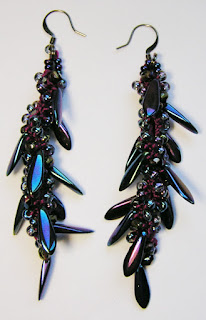
Spyro Gyro earrings by Brenda Franklin KREINIK SILK THREADS:
- Silk Bella: "Wow, this is like tatting thread," notes Vashti, ".5mm hook seems just right. I guess equiv. to #40 or #50 crochet thread."
- Silk Serica creates soft but strong stitches. "Silk Serica is fabulous with the beads," notes Gwen, "size 8 or 10 or larger [bead] is recommended because it [Serica] is thicker."
- Silk Serica or Silk Bella offer a smooth thread for handling delicate beads like pearls.
- Silk is a natural animal fiber, so silk thread complements creations with natural stones.
BEADS:
- pearls
- natural stones
- semi-precious stones
- glass: dichroic, Venetian, Czech, Delica, seed beads
- crystal beads, Swarovski and other
- sterling silver, gold, gold-filled, metal beads
- bugle beads
Where to get more information or inspiration
BOOKS:
- Betsy Hershberg, Betsy Beads, XRX Books
- "Kreinik threads could be used in place of any others these authors recommend," notes Gwen Blakely Kinsler: Bethany Barry's book, "Bead Crochet" Interweave 2004, Susan Lutz Kenyon, "Beaded Beauties to Crochet" by Leisure Arts, 2004, "Crochet with Beads" by Hazle Shake , Design Originals,2 005, Lily Chin, "Knit and Crochet with Beads"
- Brenda Franklin, "Beaded Knits Jewelry and Accessories" volumes 1, 2 and 3.
- Beading on Fabric by Larkin Jean Van Horn from Interweave Press
-
Metallic Thread Selection Guide
Which Kreinik metallic thread works best in Cross Stitch? Which Kreinik metallic thread can you use in a sewing machine? These selection questions and more answered below:
CARD MAKING, SCRAPBOOKING:
- Stitching on paper: Cord, Very Fine #4 Braid, Fine #8 Braid
- Ribbons: 1/16" Ribbon, 1/8" Ribbon
COSPLAY, COSTUMING, FASHION:
- See "Hand Embroidery" or "Machine Embroidery" lists (below)
CROCHET:
- Carry-along: Blending Filament, Ombre, Reflective Yarn
- Jewelry: Tapestry #12 Braid, Medium #16 Braid, Canvas #24 Braid
- Bead crochet: Fine #8 Braid, Tapestry #12 Braid
CROSS STITCH:
- Blending Filament (use by itself or combined with other thread like cotton embroidery floss)
- Cord (backstitching, couching)
- Very Fine #4 (on 16- and 18-count Aida or over two threads on 28-, 32-count linens)
- Fine #8 (on 14-count Aida, or over two threads on 28-count)
- Tapestry #12 Braid (12-count fabrics)
- Medium #16 Braid (11-count fabrics)
- 1/16" Ribbon (10- to 11-count fabrics)
- 1/8" Ribbon (6- to 8-count fabrics)
- Cross stitching on unusual materials, like pegboard, screens, etc? Go up to one of our larger Braids, such as Medium #16 Braid, Canvas #24 Braid, or Heavy #32 Braid); the larger the Braid number, the heavier the thread.
HAND EMBROIDERY:
- Stitch in and out of the fabric: Cord (for very fine details), Very Fine #4 Braid, Fine #8 Braid
- Couch for surface embellishment: Medium #16 Braid, Canvas #24 Braid, Heavy #32 Braid, 3/8" Trim, Facets, Petite Facets, Micro Ice Chenille, Wired Braid, 3/8" Trim
- Ribbon embroidery stitches: 1/16" Ribbon, 1/8" Ribbon, 1/4" Ribbon, Easter Grass
- Dimensional, shaped stitches: 3/8" Trim with wire, Wired Braid
KNITTING:
- Carry-along: Blending Filament, Ombre
- Bead Knitting: Fine #8 Braid, Tapestry #12 Braid
MACHINE EMBROIDERY and QUILTING:
- In the needle: Cord, Japan #1
- In the bobbin: Ombre, #4 and #8 Braids, Cord
- Couched: Facets, Petite Facets, Micro Ice Chenille, Ribbons, Braids (all sizes), Wired Braid, 3/8” Trim, Cable, Japan #5, 7
NEEDLEPOINT:
- Blending Filament (if blending with other fibers) (also can be used on 40-count silk gauze)
- Cord (backstitching, couching)
- Cable (3-ply twist for specialty stitches on any canvas)
- Very Fine #4 Braid (blending on any canvas)
- Fine #8 Braid (18-, 24-count)
- Tapestery #12 Braid (18-, 14-count)
- Medium #16 Braid (14-, 13-count)
- Canvas#24 Braid (13-, 12-count)
- Heavy #32 Braid (12-, 10-count)
- Ombre (18-count canvas, or specialty stitches)
- Couched: Petite Facets, Facets, Micro Ice Chenille, 3/8” Trim, Wired Braid, Japan Threads
- Ribbons: 1/16” (24-, 18-count canvas); 1/8” (14-, 13-count); 1/4” (12-, 10-count), Easter Grass (any canvas)
PUNCHNEEDLE:
- Blending Filament (#1 needle)
- Very Fine #4 Braid (#1 and #3 needles)
- Fine #8 Braid (#3 needle)
PLASTIC CANVAS:
- Medium #16 Braid (14 count)
- Canvas #24 Braid (10-count)
- Heavy #32 Braid (7 count)
- 1/8" Ribbon (7-10 count)
MIXED MEDIA, CRAFTS, STRING ART, OTHER FIBER ARTS:
- All fibers
SAMPLERS:
- Cord (backstitching, couching)
- Very Fine #4 Braid (over two threads on 28-, 32-, 36-count linens)
- Fine #8 Braid (over two threads on 28-count linens)
- Cable (long stitches and specialty stitches)
- 1/16" Ribbon (woven stitches)
SASHIKO:
- Very Fine #4 Braid
- Fine #8 Braid
- Tapestry #12 Braid
- 1/16" Ribbon
SWEDISH WEAVING:
- Very Fine #4 Braid
- Fine #8 Braid
- 1/16" Ribbon
- 1/8" Ribbon
TEMARI:
- Fine #8 Braid
- Tapestry #12 Braid
- Japan thread
- 1/16" Ribbon
WEAVING:
- Warp: Ombre, Ribbons (basic colors), Braids (basic colors)
- Weft: Micro Ice Chenille, Ombre, Ribbons and Braids (any color)


